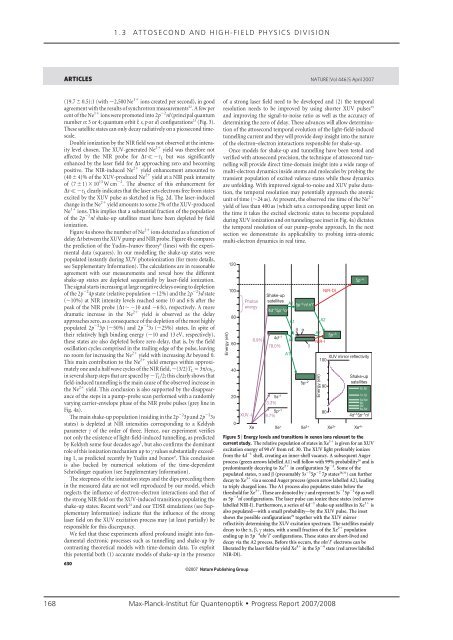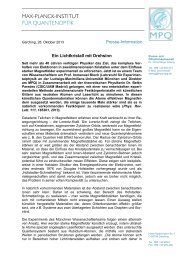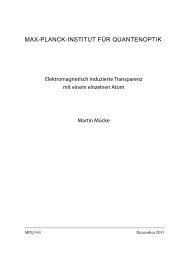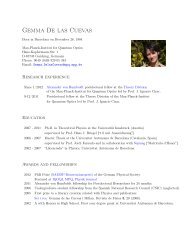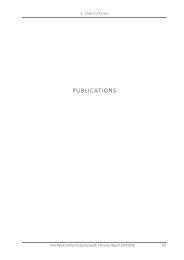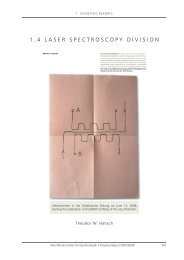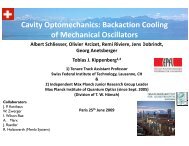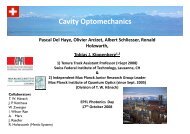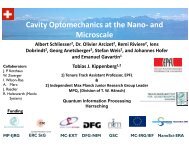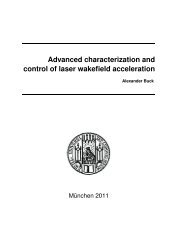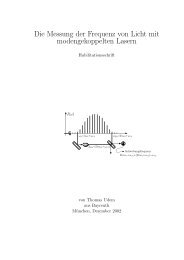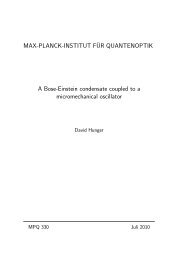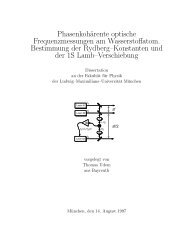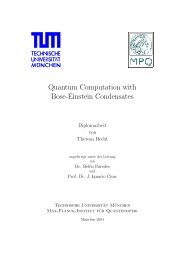Attosecond Control and Measurement: Lightwave Electronics
Attosecond Control and Measurement: Lightwave Electronics
Attosecond Control and Measurement: Lightwave Electronics
Create successful ePaper yourself
Turn your PDF publications into a flip-book with our unique Google optimized e-Paper software.
1 . 3 AT T O S E C O N D A N D H I G H - F I E L D P H Y S I C S D I V I S I O N<br />
ARTICLES NATURE |Vol 446 | 5 April 2007<br />
(19.7 6 0.5):1 (with ,2,500 Ne 11 ions created per second), in good<br />
agreement with the results of synchrotron measurements 22 . A few per<br />
cent of the Ne 11 ions were promoted into 2p 22 nl (principal quantum<br />
number n: 3 or 4; quantum orbit l: s, p or d) configurations 23 (Fig. 3).<br />
These satellite states can only decay radiatively on a picosecond timescale.<br />
Double ionization by the NIR field was not observed at the intensity<br />
level chosen. The XUV-generated Ne 21 yield was therefore not<br />
affected by the NIR probe for Dt = 2t L but was significantly<br />
enhanced by the laser field for Dt approaching zero <strong>and</strong> becoming<br />
positive. The NIR-induced Ne 21 yield enhancement amounted to<br />
(40 6 4)% of the XUV-produced Ne 21 yield at a NIR peak intensity<br />
of (7 6 1) 3 10 13 W cm 22 . The absence of this enhancement for<br />
Dt = 2tL clearly indicates that the laser sets electrons free from states<br />
excited by the XUV pulse as sketched in Fig. 2d. The laser-induced<br />
change in the Ne 21 yield amounts to some 2% of the XUV-produced<br />
Ne 11 ions. This implies that a substantial fraction of the population<br />
of the 2p 22 nl shake-up satellites must have been depleted by field<br />
ionization.<br />
Figure 4a shows the number of Ne 21 ions detected as a function of<br />
delay Dt between the XUV pump <strong>and</strong> NIR probe. Figure 4b compares<br />
the prediction of the Yudin–Ivanov theory 6 (lines) with the experimental<br />
data (squares). In our modelling the shake-up states were<br />
populated instantly during XUV photoionization (for more details,<br />
see Supplementary Information). The calculations are in reasonable<br />
agreement with our measurements <strong>and</strong> reveal how the different<br />
shake-up states are depleted sequentially by laser-field ionization.<br />
The signal starts increasing at large negative delays owing to depletion<br />
of the 2p 22 4p state (relative population ,12%) <strong>and</strong> the 2p 22 3d state<br />
(,10%) at NIR intensity levels reached some 10 <strong>and</strong> 6 fs after the<br />
peak of the NIR probe (Dt , 210 <strong>and</strong> 26 fs), respectively. A more<br />
dramatic increase in the Ne 21 yield is observed as the delay<br />
approaches zero, as a consequence of the depletion of the most highly<br />
populated 2p 22 3p (,50%) <strong>and</strong> 2p 22 3s (,25%) states. In spite of<br />
their relatively high binding energy (,10 <strong>and</strong> 13 eV, respectively),<br />
these states are also depleted before zero delay, that is, by the field<br />
oscillation cycles comprised in the trailing edge of the pulse, leaving<br />
no room for increasing the Ne 21 yield with increasing Dt beyond 0.<br />
This main contribution to the Ne 21 yield emerges within approximately<br />
one <strong>and</strong> a half wave cycles of the NIR field, ,(3/2)TL 5 3p/vL,<br />
in several sharp steps that are spaced by ,TL/2; this clearly shows that<br />
field-induced tunnelling is the main cause of the observed increase in<br />
the Ne 21 yield. This conclusion is also supported by the disappearance<br />
of the steps in a pump–probe scan performed with a r<strong>and</strong>omly<br />
varying carrier-envelope phase of the NIR probe pulses (grey line in<br />
Fig. 4a).<br />
The main shake-up population (residing in the 2p 22 3p <strong>and</strong> 2p 22 3s<br />
states) is depleted at NIR intensities corresponding to a Keldysh<br />
parameter c of the order of three. Hence, our experiment verifies<br />
not only the existence of light-field-induced tunnelling, as predicted<br />
by Keldysh some four decades ago 1 , but also confirms the dominant<br />
role of this ionization mechanism up to c values substantially exceeding<br />
1, as predicted recently by Yudin <strong>and</strong> Ivanov 6 . This conclusion<br />
is also backed by numerical solutions of the time-dependent<br />
Schrödinger equation (see Supplementary Information).<br />
The steepness of the ionization steps <strong>and</strong> the dips preceding them<br />
in the measured data are not well reproduced by our model, which<br />
neglects the influence of electron–electron interactions <strong>and</strong> that of<br />
the strong NIR field on the XUV-induced transitions populating the<br />
shake-up states. Recent work 24 <strong>and</strong> our TDSE simulations (see Supplementary<br />
Information) indicate that the influence of the strong<br />
laser field on the XUV excitation process may (at least partially) be<br />
responsible for this discrepancy.<br />
We feel that these experiments afford profound insight into fundamental<br />
electronic processes such as tunnelling <strong>and</strong> shake-up by<br />
contrasting theoretical models with time-domain data. To exploit<br />
this potential both (1) accurate models of shake-up in the presence<br />
630<br />
of a strong laser field need to be developed <strong>and</strong> (2) the temporal<br />
resolution needs to be improved by using shorter XUV pulses 25<br />
<strong>and</strong> improving the signal-to-noise ratio as well as the accuracy of<br />
determining the zero of delay. These advances will allow determination<br />
of the attosecond temporal evolution of the light-field-induced<br />
tunnelling current <strong>and</strong> they will provide deep insight into the nature<br />
of the electron–electron interactions responsible for shake-up.<br />
Once models for shake-up <strong>and</strong> tunnelling have been tested <strong>and</strong><br />
verified with attosecond precision, the technique of attosecond tunnelling<br />
will provide direct time-domain insight into a wide range of<br />
multi-electron dynamics inside atoms <strong>and</strong> molecules by probing the<br />
transient population of excited valence states while these dynamics<br />
are unfolding. With improved signal-to-noise <strong>and</strong> XUV pulse duration,<br />
the temporal resolution may potentially approach the atomic<br />
unit of time (,24 as). At present, the observed rise time of the Ne 21<br />
yield of less than 400 as (which sets a corresponding upper limit on<br />
the time it takes the excited electronic states to become populated<br />
during XUV ionization <strong>and</strong> on tunneling; see inset in Fig. 4a) dictates<br />
the temporal resolution of our pump–probe approach. In the next<br />
section we demonstrate its applicability to probing intra-atomic<br />
multi-electron dynamics in real time.<br />
Photon<br />
energy<br />
5s –1<br />
3.3%<br />
5p –1<br />
9.7%<br />
Xe Xe + Xe 2+ Xe 3+ Xe 4+<br />
168 Max-Planck-Institut für Quantenoptik • Progress Report 2007/2008<br />
Energy (eV)<br />
120<br />
100<br />
80<br />
60<br />
40<br />
20<br />
}<br />
XUV -I<br />
©2007 Nature Publishing Group<br />
0<br />
8.9%<br />
Shake-up<br />
satellites<br />
A1<br />
4d –15p –1 5p<br />
nl<br />
–4 nl n′l′<br />
4d –1<br />
78.0%<br />
A1<br />
A1<br />
A1<br />
}<br />
β α<br />
5p –2<br />
γ<br />
A2<br />
A2<br />
NIR-I<br />
Energy (eV)<br />
NIR-DI<br />
XUV mirror reflectivity<br />
100<br />
90<br />
80<br />
5p –3<br />
5p –4<br />
Shake-up<br />
satellites<br />
8s,8p<br />
4d –15p –1 7s,7p<br />
5d,6p<br />
6p<br />
5d<br />
6s,5d<br />
nl<br />
Figure 5 | Energy levels <strong>and</strong> transitions in xenon ions relevant to the<br />
current study. The relative population of states in Xe 11 is given for an XUV<br />
excitation energy of 90 eV from ref. 30. The XUV light preferably ionizes<br />
from the 4d 21 shell, creating an inner-shell vacancy. A subsequent Auger<br />
process (green arrows labelled A1) will follow with 99% probability 26 <strong>and</strong> is<br />
predominantly decaying to Xe 21 in configuration 5p 22 . Some of the<br />
populated states, a <strong>and</strong> b (presumably 5s 21 5p 22 7p states 28,31 ) can further<br />
decay to Xe 31 via a second Auger process (green arrow labelled A2), leading<br />
to triply charged ions. The A1 process also populates states below the<br />
threshold for Xe 31 . These are denoted by c <strong>and</strong> represent 5s 21 5p 22 6p as well<br />
as 5p 23 nl configurations. The laser pulse can ionize these states (red arrow<br />
labelled NIR-I). Furthermore, a series of 4d 21 shake-up satellites in Xe 11 is<br />
also populated—with a small probability—by the XUV pulse. The inset<br />
shows the possible configurations 29 together with the XUV mirror<br />
reflectivity determining the XUV excitation spectrum. The satellites mainly<br />
decay to the a, b, c states, with a small fraction of the Xe 21 population<br />
ending up in 5p 24 nln9l9 configurations. These states are short-lived <strong>and</strong><br />
decay via the A2 process. Before this occurs, the nln9l9 electrons can be<br />
liberated by the laser field to yield Xe 41 in the 5p 24 state (red arrow labelled<br />
NIR-DI).


